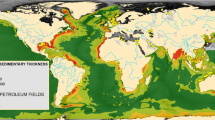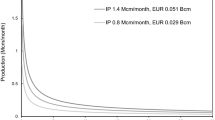Abstract
Well blowout rates in oil fields undergoing thermally enhanced recovery (via steam injection) in California Oil and Gas District 4 from 1991 to 2005 were on the order of 1 per 1,000 well construction operations, 1 per 10,000 active wells per year, and 1 per 100,000 shut-in/idle and plugged/abandoned wells per year. This allows some initial inferences about leakage of CO2 via wells, which is considered perhaps the greatest leakage risk for geological storage of CO2. During the study period, 9% of the oil produced in the United States was from District 4, and 59% of this production was via thermally enhanced recovery. There was only one possible blowout from an unknown or poorly located well, despite over a century of well drilling and production activities in the district. The blowout rate declined dramatically during the study period, most likely as a result of increasing experience, improved technology, and/or changes in safety culture. If so, this decline indicates the blowout rate in CO2-storage fields can be significantly minimized both initially and with increasing experience over time. Comparable studies should be conducted in other areas. These studies would be particularly valuable in regions with CO2-enhanced oil recovery (EOR) and natural gas storage.












Similar content being viewed by others
References
Benson SM, Cook P, et al (2005) Underground geological storage. In: Freund P, et al (eds) Intergovernmental panel on climate change special report on carbon dioxide capture and storage, Cambridge University Press, Cambridge, pp 195–276
California Department of Water Resources (undated) 1998 Kern County. http://www.landwateruse.water.ca.gov/basicdata/landuse/counties/survey_years/vector_quads/98kn.cfm. Map without scale. Accessed 13 June 2007
California Division of Oil, Gas and Geothermal Resources (1992–2006) Annual report of the state oil and gas supervisor. Publication No. PR06, California Division of Oil, Gas, and Geothermal Resources, Sacramento
California Division of Oil, Gas and Geothermal Resources (2002) Kern County oil fields. ftp://ftp.consrv.ca.gov/pub/oil/maps/dist4/Dist4_fields.pdf. Map scale approximately 1:9,200. Accessed 28 May 2005
California Division of Oil, Gas and Geothermal Resources (2006) Oil field data file dated 12/6/2006. ftp://ftp.consrv.ca.gov/pub/oil/Data_Catalog/Oil_and_Gas/Oil_fields/CA_oilfields.DAT. Cited 13 June 2007
California Division of Oil, Gas and Geothermal Resources (2007), Monthly production and injection databases. http://www.consrv.ca.gov/dog/prod_injection_db/index.htm. Accessed 13 June 2007
Energy Information Administration (2007) Crude oil production. http://tonto.eia.doe.gov/dnav/pet/xls/pet_crd_crpdn_adc_mbbl_a.xls. Accessed 13 June 2007
Gasda SE, Bachu S, Celia MA (2004) Spatial characterization of the location of potentially leaky wells penetrating a deep saline aquifer in a mature sedimentary basin. Environ Geol 46(6–7):707–720
Hauser RL, Guerard Jr WF (1993) A history of oil- and gas-well blowouts in California, 1950–1990. Publication No. TR43, California Division of Oil, Gas, and Geothermal Resources, Sacramento
Kern Council of Governments (undated) Kern County, California, cities and census designate places, Census 2000. http://www.co.kern.ca.us/econdev/maps/city-cdp.pdf. Map scale approximately 1:53,000. Accessed 13 June 2007
Keyfitz N (1966) Sampling variance of standardized mortality rates. Hum Biol 38:309–317
National Institute of Standards and Technology and SEMATECH (2008) Engineering statistics handbook. http://www.itl.nist.gov/div898/handbook/index.htm. Accessed 29 April 2008
Occupational Safety and Health Administration (2007), Oil and gas well drilling and servicing etool. http://www.osha.gov/SLTC/etools/oilandgas/index.html. Accessed 13 June 2007
Schlumberger (2007) Oilfield glossary. http://www.glossary.oilfield.slb.com/default.cfm. Accessed 13 June 2007
Skinner L (2003) CO2 blowouts: an emerging problem. World Oil 224(1):38–42
San Joaquin Geological Society (2007) The history of the oil industry (with emphasis on California and Kern County). http://www.sjgs.com/history.html. Accessed 13 June 2007
Standing MB, Katz DL (1942) Density of natural gases. Trans AIME 146:141–149
United States Census Bureau (2007) American FactFinder. http://factfinder.census.gov/home/saff. Accessed 13 June 2007
Acknowledgments
We are grateful to Michael Stettner (Underground Injection Control Manager for DOGGR) for coordinating provision of the blowout data, and answering questions, Dave Mitchell (District 4 office) for supplying the digital blowout data, and Dan Tuttle and Mark Gamache (District 4 office) for answering questions, running queries, and supplying paper blowout record copies. We thank Estella Aguilar and Mary Fuller at the Bakersfield Californian for their patience in comprehending our request, subsequently diligently searching the newspaper’s archives, and providing articles regarding blowouts in District 4. These articles were critical to increasing our confidence in the outcome of this study. We are also grateful to Alfredo Urdaneta (Aera Energy) for answering numerous questions about thermally enhanced production parameter values in general and in District 4. Michael Stettner and Dan Tuttle (DOGGR) kindly reviewed the paper, and Curt Oldenburg and Jens Birkholzer (LBNL) also provided valuable reviews (twice!). Jens’s review in particular led to 1) the incorporation of more data streams in the analysis, and 2) the realization that well-head pressure, more than any other parameter, correlated with blowout rate. Comments from Sean Brennan, Environmental Geology's reviewer, led to the statistical analysis section, which significantly strengthened the paper. David Schlessinger, of Kaiser Permanente, kindly volunteered to advise us on this aspect of the paper. This said, the authors take full responsibility for the data analysis and conclusions.
This work was supported by the Assistant Secretary for Fossil Energy, Office of Coal and Power Systems, through the National Energy Technology Laboratory (NETL) under Department of Energy Contract No. DE-AC02-05CH11231.
Author information
Authors and Affiliations
Corresponding author
Electronic supplementary material
Below is the link to the electronic supplementary material.
Rights and permissions
About this article
Cite this article
Jordan, P.D., Benson, S.M. Well blowout rates and consequences in California Oil and Gas District 4 from 1991 to 2005: implications for geological storage of carbon dioxide. Environ Geol 57, 1103–1123 (2009). https://doi.org/10.1007/s00254-008-1403-0
Received:
Accepted:
Published:
Issue Date:
DOI: https://doi.org/10.1007/s00254-008-1403-0




